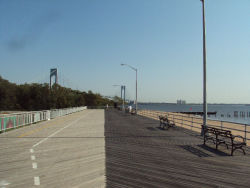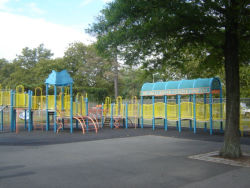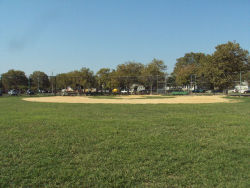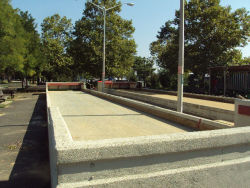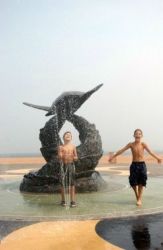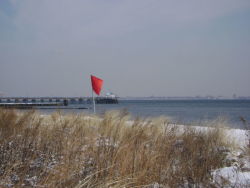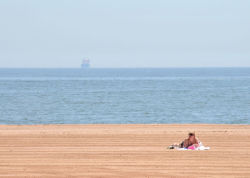Franklin D. Roosevelt Boardwalk and Beach
Capodanno Memorial
This memorial, located along Seaside Boulevard and the Franklin Delano Roosevelt Boardwalk and Beach, commemorates the Congressional Medal of Honor recipient and Vietnam War veteran Father Vincent Capodanno (1929-1967).
Navy Chaplain Lieutenant Vincent R. Capodanno is one of many veterans memorialized in this area. The nearby Midland Beach War Memorial commemorates the sacrifices of many local citizens who served and died during World War II, the Korean War, and the Vietnam War. During a battle in the Quang Tin Province of Vietnam during the Vietnam War in 1967, Capodanno left the safety of his company command post and rushed to the aid of an overrun company of marines on a nearby active battlefield. Under heavy fire with mortar rounds exploding at his feet, he acted without regard for his own safety, charging into the combat area to render medical aid and comfort to the wounded and the dying. Though he suffered multiple wounds to his arms and legs and severed a portion of his right hand, Capodanno refused medical aid and directed his attentions to attending the other wounded. He was rushing to the aid of a wounded soldier under direct enemy fire from a machine gun fifteen yards away when he was struck down by a burst of machine gun fire.
Posthumously awarded the Congressional Medal of Honor, Capodanno was memorialized in his Staten Island community in the early 1970s when a nearby boulevard was named for him. The granite monument in this park was dedicated in 1976. The Madonna Council of the Knights of Columbus, which bears Father Capodanno’s name, donated the funds for the memorial.
The Franklin Delano Roosevelt Boardwalk and Beach have long provided New Yorkers a refuge from the congestion and confinement of city life. Colonized in 1661 by a small Dutch community, the coastal neighborhoods of Middle and South Beach changed little until the l880s. Around that time, local investors recognized the potential of teeming beaches filled with New Yorkers trying to escape the city’s summer heat. With the addition of hotels, bathing pavilions, theaters, beer gardens, shooting galleries, carousels and ferris wheels, the beachfront area became a resort almost overnight.
Soon the casinos and the Happyland Amusement Park took advantage of the summer seasonal closing of most Broadway theaters by staging their own theatrical productions and vaudeville shows. By 1890, ferries, trains and trolleys filled to capacity with vacationers and day-trippers trying to reach Staten Island’s beaches. In the 1920s, the number of Staten Island visitors could run upwards of 40,000 per day. Eventually several destructive fires, increasing local water pollution and the Great Depression (1929-1939) took their toll on the beachfront resort area and the crowds began to disappear rapidly.
In 1935, the City acquired this beachfront property and soon began renovations as part of President Franklin Delano Roosevelt’s (1882-1945) Works Progress Administration (W.P.A.). While providing jobs for Depression-era workers, the project also revived the community of South Beach. Workers removed the deteriorating music halls, carousels, and shooting galleries and laid down the present two and a half-mile long boardwalk. In 1939, the boardwalk was dedicated to the former New York governor and president; and it has since continued to undergo periodic renovations and neighborhood improvements. Children can now enjoy playgrounds, baseball fields, and handball and shuffleboard courts maintained by Parks. Visitors can also enjoy bocce courts, checker-tables, a skateboard park, a roller hockey rink and a long pier for year-round fishing.
Check out your park's Vital Signs
Clean & Safe
Green & Resilient
Empowered & Engaged Users
Share your feedback or learn more about how this park is part of a
Vital Park System


